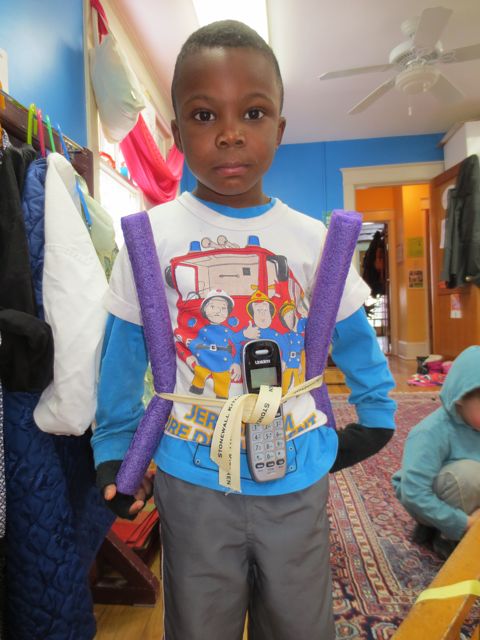Planned Serendipity, A Discussion About "Child-led Curriculum"
“It's a combination of serendipity and preparedness. Without planning, we'd never have found Tiktaalik. But often you make plans and then throw them away as soon as you begin your work. The moment of discovery is always serendipity. But if you haven't done your homework, you'll miss it.” (Neil Shubin, paleontologist and evolutionary biologist about discovering Tiktaalik, a lobe-finned fish from the Devonian period). Each year the teachers at our cooperative school conduct home visits with our new students. Even though there are other opportunities to meet the children, these short, just 15-minute, visits bring the “us” onto the home turf and it changes the conversation. At first, the child sits mostly silent with eyes wide as if to say, “This is the person called teacher?”
Words are not needed to give a quick tour of favorite places to play or to show special toys, books, or well-loved items. Those are sometimes pushed towards us with pointed toes while faces are tucked under a parent’s arms or behind backs. We use these visits to make sure that we have familiar items and books in the classroom – things that will make the home to school transition a bit easier. We also leave a pamphlet we have prepared about starting school along with the child’s laminated symbol to attach to his or her backpack. I call that their key to school. It is the first of the totems that will mark what is solely theirs.
It was from one of these home visits and the days following that I learned about how I personally interact with the idea of “child-led curriculum.” It was the first year that I was taking over as director and lead teacher. Even though I had been teaching for a few years, I was actively working through what kind of teacher I would be on my own rather than following the lead of another. During one of my last home visits, I noticed a stack of miniature paper purses, backpacks, and bags the child had made. These were collected in the living room along with paper, pencils, pens, scissors, and tape that the child used to make them, left aside for my visit. These were fascinating, each designed and decorated just so. When I asked about them, the child perked up and began to tell the story of each one.
Leaving, I felt inspired as ideas percolated about how to transfer this passion and story into the classroom. There was something symbolically important to me about the idea of organizing and holding precious items inside a container at this particular time. It was like a portable nest, a thing that collected loose ends and items you need for both emergencies and mundane tasks. It spoke to me.
That weekend, I went through my own collection and also went to the thrift shop and collected a variety of purses, bags, and totes. I displayed these on the shelves. This would be the spark, wouldn’t it? And our little paper purse/bag maker would take it to the next level. Who could resist my collection of vintage purses, rhinestones galore, beads stitched onto straw and velvet along with small celluloid and lacquer cases with latches and hooks?
The children, that’s who.
I packed up the assortment and folded up shop on that idea after a week and a half. Here is what I learned and I was able to connect this to my previous life as a video producer/script writer. When a documentary filmmaker and camera are introduced into a scene involving humans, especially those working and living collectively, the situation that unfolds will be different than if there were no camera there. Further, images are captured purposefully by the filmmaker’s lens to encourage the audience to identify with the subject. We are storytellers, every one of us in our own way. Teachers, just like filmmakers with cameras, will directly shape the environment AND will shape the story that unfolds. And this is not wrong. It simply is and I must work from a place of understanding this dynamic.
What I learned from the “You Think Purses Are a Great Idea, But We Don’t” episode is that I have already changed the play by stepping into the room. I bring my own play history and preferred play arcs. I learned that by providing certain materials as well as arranging the furnishings in the room, I change, direct, or in the case of the purses, end pursuits. In fact, our documentation about our curriculum features lists of materials, shelf contents, literature, dramatic play supports, books, and room arrangement. In other words, our curriculum IS first and foremost our environment. Additionally, environment includes adults and all encircle and support the child. I must own that my presence and my decisions and those of the other adults to respond, offer, or act upon some ideas over others will subtly or profoundly change the flow of the children’s pursuits.
This is why I tell prospective parents that the materials we offer are selected and crafted by something we call thematic units – we choose the themes because they echo or reflect themes found in children’s literature and will give rise to play that can be mapped out by the children from these stories or inspired by the ideas expressed in them. I feel that this is important to further explain “child-led” in terms of what we do at our school.
Yes, the play is child-led, but the environment and materials are most certainly selected by adults. Although the play will vary from group to group, there will be consistent themes in the play and a common language will be established over time. This language and its play arcs are shared with siblings and between groups of children attending our school over the years.



